NEWS
Stanford created “artificial lungs” that turn water into fuel

A team of researchers from Stanford University has published the results of tests of an experimental unit for the production of hydrogen. The raw material in it is ordinary water, and this technology is distinguished by its working principle, which is copied from the human lungs. It is simpler, more efficient and cheaper than traditional methods of generating this gas.
Scientists copied the membrane for gas separation from the lung, only in this case not only oxygen is extracted from the initial mixture, but also hydrogen, which together form the fuel mixture. To improve the efficiency of water splitting, platinum and gold electrocatalysts are used; the process itself is initiated when an electric current is applied to the liquid. Zest - in the design of the membrane. It has been shown that it has been shown that it has been scored. To improve the efficiency of water splitting, platinum and gold electrocatalysts are used; the process itself is initiated. Zest - in the design of the membrane.
Geometry plays a key role, say the authors of the study. They applied a layer of metal catalysts on one side of a 12 nm thick polymer film, and on the other, they created a series of pores. They are too small for the passage of water molecules, but the gas molecules pass freely, and, thanks to catalysts, the whole process is accelerated several times, requiring 32% less energy than using standard carbon membranes.
The film was rolled into a sort of bag and placed in water; now all the hydrogen fuel produced will accumulate inside. Due to the special shape of the membrane surface, no bubbles form on the process, the reactions proceed evenly, the pressure changes gradually and there is practically no wear of the catalytic layer — a loss of 3% after 250 cycles versus 74% after 70 cycles on carbon membranes. Now scientists have to figure out how to make this system cellular, by analogy with the same human lungs.




